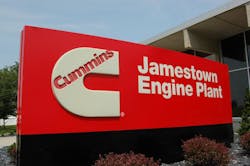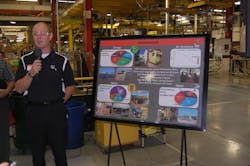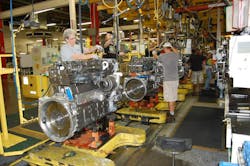[And though it’s named after Jamestown, NY, the factory is really located in the village of Lakewood, NY, which is about a 15 minute or so drive from downtown Jamestown.]
One of the interesting things about the Jamestown factory is the ongoing multi-year effort to cut facility operating costs by reducing energy usage, water consumption, etc. In year four of a five year plan, the plant expects to be saving about $1 million a year via its “bundled energy plan” by the end of 2015.
[To view more photos of the Jamestown plant, click here.]
Now, a million dollars might not sound like a lot of money anymore in this day and age, but from where I sit, that sure is nothing to sniff at. You could put together some nice bonuses for the 1,600 or so JEP employees with a pool of cash like that or help fund annual snow removal operations around the facility.
[Though, despite being inundated by over 8,500 inches of snow over the last four decades, the plant’s never suffered a lost day of production due to the white stuff.]The JEP facility is generating those savings from a host of different areas, too. For example, a new high-efficiency engine wash system (for removing leftover debris from the manufacturing process) consumers 10,000 fewer gallons of water. All told the plant has cut its water usage from 30 million gallons a year down to just over 18 million gallons.
A fully insulated R19 roof combined with a 7,500 solar panel array is expected to save $150,000 a year in electricity costs, while a switch back in 2007 from oil- to water-based paints has helped lower VOC [volatile organic compound] emissions by 50%, with another 39% drop engineered starting last year from the use of new paint formulations.
Fewer VOCs, by the way, means less filtration on cleanup costs, thus again shaving more money from JEP’s operational cost ledger.
The JEP plant as a whole, though, is a testament to cost control in a way. Cummins acquired the more than 1-million-square-foot facility in 1974, using it initially to manufacture engine components. The plant produced its first engine in 1979.
But back in 2002 the OEM decided to consolidate all of its heavy-engine production at the site – a wrenching decision at the time, as that meant closing down heavy engine production at the OEM’s headquarters in Columbus, IN.
Ignacio Garcia, a VP with Cummins’ Mexico operations, served as the JEP manager from 1998 to 2003, which encompassed that difficult transition period. He noted it took 90 truckload trailers to relocate all the manufacturing apparatus from Columbus to Jamestown – a feat accomplished over the Christmas holidays, so JEP would be ready to start building heavy engines during the first week of 2003.“We only had the night of Christmas off with our families during that time,” Garcia said during a speech during JEP’s 40th anniversary celebration. “We had only just introduced the ISX platform in 1999 so there was some concern about the overall future of heavy truck engines. But today it is our best engine.”
[Currently, the JEP facility builds about 500 mostly on-highway engines per day, including the ISX15, the ISX12 and ISM diesel engines, the Cummins Westport ISX12 G spark-ignited natural gas engine, plus QSM and QSX units that serve off-highway customers in construction, agriculture and marine applications.]
Yet Garcia also noted that competition is only increasing in the heavy-duty truck engine market, especially in the U.S., as truck OEMs now directly compete with Cummins by offering their own line of proprietary engines.
Thus Garcia stressed that any improvements in engine design or manufacturing cost structure – even if it only means shaving off a million bucks a year from the operating budget – can pay larger dividends in the future. “The work and the market are changing, so we must keep working hard to succeed,” he said.



